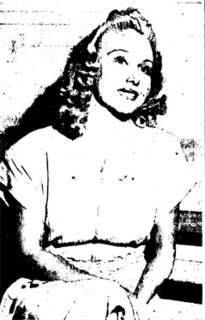Los Angeles
On Saturday night, officers B.J. Daily and R. W. Douglas broke up a fight between a couple who were brawling in the middle of Santa Monica Blvd. at Purdue Ave. The man had a gash between his eyes, and both seemed drunk, so while they seemed a little more refined than most of the lushes, down they went to Lincoln Heights Jail with the rest.
Turns out “refined†is the right word-the gent was John D. Spreckels III, 36, debt-ridden heir to the sugar fortune, the lady his 37-year-old wife. Lou Dell Spreckels denied that she was drunk, explaining that they were fighting because she had refused to give John money to go gambling, and so he had struck her. “What are you going to do when someone starts hitting you? So we had a fight.†Makes sense to us!
Both gave their address as a motel at 2500 Santa Monica Blvd. They were each released on a $20 bond and ordered to appear in court at 2pm today to answer the public intoxication charge.

Golfers Play On
as Fire Sweeps
Inglewood Club
Fire which mushroomed early yesterday from the basement of the clubhouse at the Inglewood Country Club, 3424 W. Manchester Blvd., Inglewood, left the building and its furnishings a heap of charred or water-soaked debris but failed to deter golfers from enjoying their Sunday on the greens. For a score of golfers putted even while the clubhouse burned.
The cause undetermined, the fire swept through two locker rooms and the grill and then spread to the roof of the L-shaped building. Officially, damage was estimated at $50,000 ($473209.30 USD 2005).
Three fire companies from Inglewood and one from Los Angeles answered the alarm. A large crowd of spectators was attracted to the scene by the billowing smoke and flames that shot 100 feet into the air.
+ + +
The links opened in 1923 as the Portero Country Club, occupying a large, jagged chunk of land next to Hollywood Park, like the outline of a Stealth bomber with the nose at Manchester and Crenshaw, with one wing ending at Prairie Avenue/Avenue of the Champions and the other at Century Boulevard. It was a par 36-35-71 with 6,339 yards.
“No one calls Inglewood the finest test of championship golf hereabouts, but the members there feel the course has been toughened enough to make it an interesting outing for the top pros, both men and women, who participate,â€Â The Times’ Charles Curtis said before the 1955 L.A. Open, which had a total purse of $32,500 for all events.
Sam Snead and Ben Hogan played there—as did Clark Gable and Shirley Temple. And Babe Zaharias. At the first national championship for blind golfers, retiree Clinton J. Russell came in first, followed by Charles Boswell, who was blinded in World War II, winning a chance to play an exhibition round with Bob Hope and Bing Crosby.
The first attempt to develop the course came in 1952, but was apparently deflected. The land was acquired by neighboring Inglewood Park Cemetery. More development plans were made in the 1960s. By 1964, some land had been sold for a condominium project, while a parcel was left for a nine-hole course.
Finally, the Forum came and the entire site was developed.
But here’s a little bonus from research: trick shot artist Al Ashton, who put on an exhibition in 1943 for the Southern California War Workers Golf Tournament.
Ashton liked to tee up a ball on a watch or someone’s toe. He could knock a ball into his own pocket, then drive half a dozen balls, hitting the last one while the first was still in the air. Ashton guaranteed 200 yards on a ball, hitting with one hand (either one) and standing on one leg (you guessed it, either one). He said he could break 80 on any course in the country alternating his shots right-handed and left-handed.
“Funny thing about trick shots. The ones which look tough are easy while the easy ones look tough,â€Â Ashton says. I guess he gave trick quotes as well.
https://www.lmharnisch.com